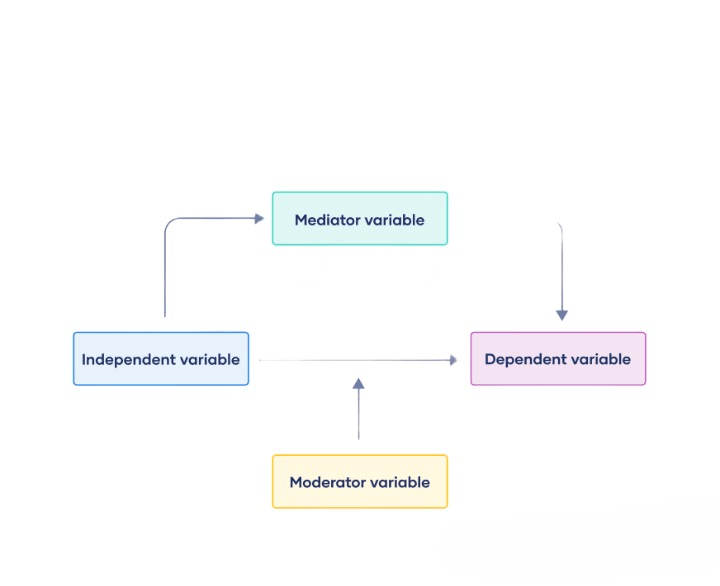The Similarities and Differences between Mediation and Moderation Analyses

Moderation and mediation analyses are two statistical techniques used in the field of causal inference. But they both serve different purposes and have distinct characteristics. Understanding the similarities and differences between these two techniques is vital when choosing the appropriate method.
Mediation analysis explores the process by which an independent variable (IV) influences a dependent variable (DV), specifically through another variable, known as the mediator. This analysis aims to uncover the underlying mechanism or pathway that explains the effect of the IV on the DV. Researchers often use structural equation modeling (SEM) for this purpose, focusing on the causal connections that lead from the IV to the DV via the mediator.
On the other hand, moderation analysis investigates when or under what conditions the effect of the IV on the DV changes. It identifies a third variable, called the moderator, which alters the strength or direction of the relationship between the IV and DV. This type of analysis is typically conducted using multiple regression analysis, highlighting the circumstances under which the impact of the IV on the DV varies.
While both mediation and moderation analyses are employed to dissect the causal relationships between variables, they serve distinct functions. Mediation is concerned with explaining the pathway through which an effect occurs, answering the “how” and “why” questions about the relationship between the IV and DV. Moderation, conversely, focuses on the “when” or “under what conditions” the relationship between the IV and DV changes, indicating the context in which this effect is observed.
Need help with your analysis?
Schedule a time to speak with an expert using the calendar below.
User-friendly Software
Transform raw data into written, interpreted, APA formatted Mediation and Moderation results in seconds.
The core difference lies in their focus: mediation analysis seeks to understand the process linking the IV and DV through a mediator, while moderation analysis examines how the relationship between the IV and DV is affected by the presence of a moderator variable. Mediation sheds light on the causal mechanisms at play, whereas moderation reveals the contexts in which these relationships are strengthened or weakened.
In summary, mediation and moderation analyses are key statistical methods used for causal inference, each with unique purposes and approaches. Mediation analysis delves into the mechanism by which the IV affects the DV through a mediator, whereas moderation analysis determines the conditions that alter the IV-DV relationship. Recognizing the distinctions and similarities between these techniques is crucial for selecting the most appropriate analytical approach in research.
Healthcare Example: Mediation Analysis
Scenario: Researchers are interested in understanding how a new physical therapy program (independent variable) improves patients’ mobility (dependent variable) after knee surgery. They suspect that the improvement in mobility is due to increased muscle strength (mediator) that the therapy program promotes.
Mediation Analysis: The researchers set up a study where patients’ muscle strength is measured throughout the therapy program. Using mediation analysis, they aim to demonstrate that the physical therapy program directly increases muscle strength, which in turn leads to improved mobility. This analysis would help in confirming that the key mechanism by which the therapy program enhances mobility is through strengthening muscles. If the mediation is significant, it supports the conclusion that muscle strength is a crucial intermediary in the recovery process.
Social Science Example: Moderation Analysis
Scenario: A study is designed to examine the effect of a new educational program (independent variable) on student performance (dependent variable). Researchers hypothesize that the effectiveness of the program varies by the initial skill level of the students (moderator).
Moderation Analysis: In this case, multiple regression analysis is used to assess how the relationship between participation in the educational program and student performance differs across students of varying skill levels. The analysis might reveal that the program significantly improves performance for students with lower initial skill levels but has less impact on students who already possess high skill levels. This moderation analysis underscores the importance of considering initial skill level as a critical factor that influences the program’s effectiveness.
These examples illustrate how mediation and moderation analyses can be utilized to gain deeper insights into the mechanisms and conditions under which specific interventions or programs exert their effects. In healthcare, mediation analysis helps unravel the processes underlying treatment outcomes, while in social science, moderation analysis sheds light on the contexts that enhance or diminish the effectiveness of educational programs.
Additional Resources
What is the difference between moderation and mediation?
Modern Approaches to Moderation and Mediation

We work with graduate students every day and know what it takes to get your research approved.
- Address committee feedback
- Roadmap to completion
- Understand your needs and timeframe